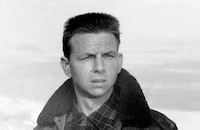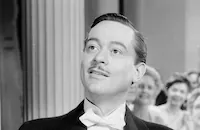Fearless Fagan

Brief Synopsis
Cast & Crew
Stanley Donen
Janet Leigh
Carleton Carpenter
Keenan Wynn
Richard Anderson
Ellen Corby
Film Details
Technical Specs

Synopsis
Floyd Hilston, a clown at Owen Gillman's circus, is devoted to "Fearless Fagan," a lion he has raised since Fagan was four days old. Through Floyd's gentle care, Fagan behaves more like a pet than a wild animal, much to the chagrin of lion tamer Emil Tauchnitz, who beratees Floyd for his naïvité. One day, Gann, an FBI agent, comes to the circus to arrest Floyd for draft-dodging, but sympathetically gives him a day to enlist when he realizes that the circus moved around too much for Floyd to receive his notice. Floyd is happy to serve his country, but worried about Fagan, refuses to let him stay with the circus, and Emil. Having no luck in finding the perfect home, Floyd sneaks Fagan into the woods on Fort Ord, when Floyd must report. Each day Floyd sneaks off to romp with Fagan and play his favorite song on the phonograph, but the rest of Fagan's time is spent in Floyd's van. At formation one morning, Sgt. Kellwin reads a statement that the Army is initiating a new policy to try to make servicemen happy, and tells the men to come to him with their problems. After dozens of soldiers give phony excuses for receiving leaves, Kellwin is disgusted and thinks that Floyd's explanation of needing time to look for a home for his pet lion is just another ruse. A few days later, while Floyd is paying his daily visit to Fagan, Abby Ames, a singer who is coming to entertain on the base, stalls her car near the van. Hearing music, Abby goes to investigate. She is frightened of Fagan, but Floyd, who recognizes her from posters, assures her that he is harmless and asks her not to tell anyone about seeing him. That night, after breaking her promise, Abby accompanies company commander Col. Horne and several soldiers to find Fagan. When they cannot locate him, Horne accuses Abby of orchestrating a publicity stunt. To prove Horne wrong, Abby tells him that "the soldier," whose name she does not know, has promised to come to her dressing room after the show. When Floyd shows up, he is arrested, but after he honestly reveals what happened, and Kellwin comes forward to say that Floyd had tried to enlist his aid, Horne decides to help. Horne then assigns Kellwin the job of finding a good home for Fagan. Kellwin has no success, until Abby, who has softened toward the affable Floyd, suggests that they try publicity. With the help of photos of the pair participating in various activities, their story becomes front page news and a nearby farm family, the Ardleys, offers to take Fagan. After saying his goodbyes to the lion, Floyd tells Abby that he loves her and is making her beneficiary of his Army life insurance, as well as Fagan's guardian, in case anything happens to him. Though she still thinks Fagan is masking his true nature, she is touched and agrees. Some time later, the company goes on night maneuvers. Meanwhile, the lonely Fagan paces his cage and opens the latch, just as he used to do in the circus act. He ambles onto the base, where he terrifies a barracks of WACS when he casually walks to the radio to listen to his favorite song, "The Loveliest Night of the Year." Fagan then wanders out into the woods and frightens Kellwin and some other soldiers. When Floyd is told to make contact with Kellwin on the walkie talkie, Fagan, recognizing Floyd's voice, cuddles the device. Kellwin, who is hanging from a tree, screams that the lion is there, and Floyd and Capt. Daniels rush to the rescue. The next day, when the Ardleys tell Horne that they can no longer keep Fagan, the colonel has no other choice than to tell Floyd that he must either let Gillman have the animal until his enlistment is up, or chloroform Fagan. Although he still fears that Gillman will enable Emil to mistreat Fagan, Floyd agrees to place him with the circus. Rather than let Fagan go, Floyd decides to go AWOL and puts him into the van. He is stopped only by Abby, who does not want him to get in serious trouble, and blocks the van with her car. As they argue, Gillman and Emil arrive and Emil takes charge of Fagan. Emil's rough treatment frightens, then angers Fagan, and he attacks Emil. Floyd fails to soothe Fagan by playing circus music, but Kellwin and some soldiers arrive in time to save Emil. He has been mauled, and has hurt Fagan's mouth during the attack and the lion runs off. Realizing that the wound will turn Fagan into a killer, Floyd asks for Emil's gun and goes after Fagan. Abby follows closely behind and begs Floyd to shoot when they find Fagan, but Floyd cannot. Fagan then attacks Floyd's leg, but despite his intense pain, Floyd gently calms Fagan down. Abby then runs to get the van and manages to lure the animal into his cage with soothing words and his toy duck. The next day, Kellwin visits Floyd in the hospital and assures him that his leg will be fine and that Emil is not badly hurt. He also says that Horne has arranged for him to have the soldier's medal and a ten-day pass to visit Abby and Fagan in Hollywood. After Floyd has recuperated, he goes to Abby's house and is shown into the living room by her maid. When he sees a lion skin rug on the floor, he is aghast, until Abby takes him outside and shows him that Fagan is happily taking a swim in her pool.

Director

Stanley Donen
Cast

Janet Leigh

Carleton Carpenter

Keenan Wynn

Richard Anderson

Ellen Corby
Barbara Ruick
John Call

Robert Burton
Wilton Graff

Parley Baer
Jonathan Cott
Fearless Fagan
Budd Jaxon

Alvy Moore

Paul Burke
Jim Moloney
William Pullen
Richard Landry
Darren Dublin
Fred Datig Jr.
David Holt
Bill Foster
Ken Miller
Jeff Weston
Bobby Walberg
Norman Wayne
Chuck Courtney
Wally Russell
Jack Rogers
Eddie Marr
Donald Kerr
Charles Campbell
William J. O'brien
Clark Jack
George "shorty" Chirello
Steven Coit
Douglas Henderson
Fred Eisley
Marvin Jones
Drew Cahill
John Close
Steve Mitchell
Frank Mullen
Roger Mcgee
Robert Easton

Mae Clark
Minerva Urecal
Helen Eby-rock
Stu Wilson
Frank Hyers
Tom Daly
Dick Ryan
Gary Jackson
Mickey Little
Rudy Lee
Joseph Keane
Larry Hickey
Ralph Michels
Tony Craig
Dorian Johnston
Wilson Wood
Joanne Tree
Wendy Waldron

Beverly Campbell
Sarah Spencer
Jan Bryant
Janet Stewart

Dean Miller
Hank Weaver

William Campbell

Russ Conway
Gil Perkins

John Eldredge
Paul Savage
Ted Eckelberry
Pat Holmes
Robert Ward Wood

Gregory Walcott
Charles Regan
Carey Loftin
Anna Q. Nilsson
Robert Ebright
Crew
Irving Aaronson
Ralph Blane
Frederick Hazlitt Brennan
Tom Crawford
Sidney Franklin Jr.
Sidney Franklin Jr.
Cedric Gibbons
A. Arnold Gillespie
Eldon W. Griffiths
Sydney Guilaroff
Floyd C. Humeston
Jackie
Sgt. Herbert M. Jones
Edwin H. Knopf
Rudolph G. Kopp
Charles Lederer
Harold Lipstein
Fred Maclean
Jay Marchant
Hugh Martin
Vickie Nichols
Tom Ordoque
Bill Orr
Ralph Pender
Robert Quirk
Elaine Ramsey
Juventino Rosas
Dave Saltuper
Robert Saunders
Douglas Shearer
William Tuttle
Leonid Vasian
Paul Francis Webster
George White
Edwin B. Willis
Adolph Zimmer

Videos
Movie Clip


Film Details
Technical Specs

Articles
Fearless Fagan
Though it sounds like a far-fetched plot even for the movies, the screen adaptation was backed up by some top-notch credentials. The screenplay for Fearless Fagan was penned by Charles Lederer, whose impressive film credits include scripts for His Girl Friday (1940), Gentlemen Prefer Blondes (1953) and Ocean's Eleven (1960). Also behind the scenes was director Stanley Donen who had just finished up the incredibly successful Singin' in the Rain (1952). Fearless Fagan also starred Janet Leigh, who only five years into her career had already appeared in crowd-pleasers like Little Women (1949) and Angels in the Outfield (1951). In addition the movie provided musical funnyman Carleton Carpenter his first leading role.
Despite a warm reception with the public, the talent behind Fearless Fagan thought the film was little more than a trifle. Janet Leigh remembers feeling forced to do the picture. "None of us wanted to be a part of this," she admitted. "Not Stanley Donen, not Carlton Carpenter, not me. It was the first time I had felt any rebellion about an assignment." Leigh was right about Donen, who claimed he "did the film only out of a sense of responsibility." Donen went on to call the script and the film "equally mediocre." Of course any picture coming on the heels of Singin' in the Rain would have had it rough. In fact, the reviewer for Variety complimented Donen's direction on Fearless Fagan. "Stanley Donen deserves laurels for his skillful integration of animal scenes with a moving story," the review read. "He never permits the picture to become maudlin or unconvincing."
The review also praised the film's animal talent: "the film's star is Fagan," said Variety. "The animal being so well trained that it never gets out of character as the affectionate, well-instructed pet of the Army private." Some reports claim that another lion, the seasoned veteran Jackie, stood in for Fagan in some scenes, but it was Fagan that received star-on-the-rise billing: the opening credits of the film read, "and introducing Fearless Fagan (Himself)."
Humeston was granted leave from the Army to serve as technical advisor on the film. As part of the Private's agreement with MGM, Fagan resided at MGM's animal compound for the remainder of Humeston's enlistment. MGM had designs on making a sequel to Fearless Fagan but the plans were eventually dropped. Humeston's enlistment was up in 1952. As for Fagan, he found a home with the Monterey County Humane Society.
One final thing to note in Fearless Fagan is the music. The song "The Loveliest Night of the Year," which is used to calm Fagan throughout the film, was featured in The Great Caruso (1951) with Mario Lanza. And the song, "What Do You Think I Am?" used by Janet Leigh's character to entertain the troops was borrowed from Best Foot Forward (1943).
Producer: Sidney Franklin, Edwin H. Knopf
Director: Stanley Donen
Screenplay: Frederick Hazlitt Brennan, Sidney Franklin, Eldon W. Griffiths, Charles Lederer
Cinematography: Harold Lipstein
Film Editing: George White
Art Direction: Cedric Gibbons, Leonid Vasian
Music: Rudolph G. Kopp
Cast: Janet Leigh (Abby Ames), Carleton Carpenter (Pvt. Floyd Hilston), Keenan Wynn (Sgt. Kellwin), Richard Anderson (Captain Daniels), Ellen Corby (Mrs. Ardley), Barbara Ruick (Second Nurse).
BW-79m.
by Stephanie Thames

Fearless Fagan
Quotes
Trivia
Notes
The title of the film's original story was "Homer and the Lion." "Fagan's" credit reads: "And introducting Fearless Fagan (Himself)" in the opening credits, but his name does not appear in the end credits. Keenan Wynn, as "Sgt. Kellwin," provides an intermittent narration to the film. According to a Hollywood Reporter news item, Debbie Reynolds was to have been the female lead in the film. Another Hollywood Reporter news item includes Bob Savage in the cast, but his appearance in the released film has not been confirmed. Fearless Fagan marked the motion picture debut of actor Anthony Eisley, who was billed in the film as Fred Eisley.
According to news items and feature articles, the film was based on actual events that happened to Army Pfc. Floyd C. Humeston. Humeston, whose story was documented in the February 12, 1951 Life magazine article "Fearless Fagan Finds a Home" by Eldon W. Griffiths, was a young animal trainer who bought the six-day-old "Fagan" at the World Jungle Compound in Thousand Oaks, CA. Humeston and his mother, who was also an animal trainer, raised the cub to be gentle, and Humeston eventually included Fagan and several other lions in an act for the Kelly and Moore Bros. Circus. Just like his onscreen alter ego, "Floyd Hilston," when Humeston was drafted, he could not find a suitable home for Fagan and took him with him to Ford Ord, CA. Fagan was eventually placed in the care of the nearby Monterey County Humane Society. According to contemporary information, Humeston received occasional leave from the U.S. Army to work as a technical advisor on the film. The Daily Variety review noted that "longtime cinema lion" "Jackie" stood in for Fagan in some sequences. According to a Hollywood Citizen-News article, by terms of Humeston's agreement with M-G-M, after the film was completed, Fagan remained as a resident of M-G-M's animal compound until Humeston's enlistment was up in October 1952. An item in the Hollywood Reporter column "Rambling Report" announced that M-G-M was planning a sequel to Fearless Fagan, but none was made.

Miscellaneous Notes
Released in United States August 1952
Released in United States Winter January 1, 1952
Released in United States Winter January 1, 1952
Released in United States August 1952













